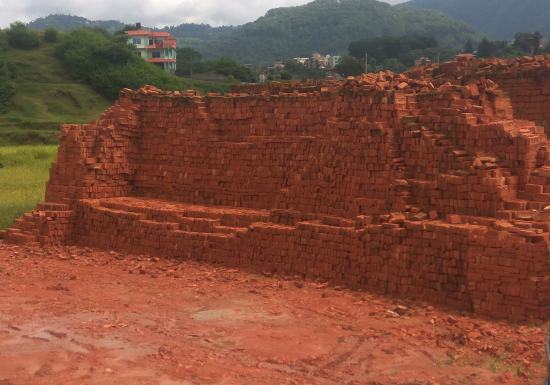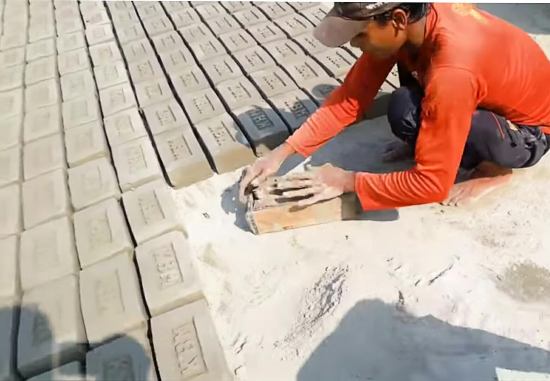Here, we will discuss AAC blocks vs Red bricks one by one. Now, let us discuss about red bricks at first, then we will move toward AAC blocks.
What is Red bricks?
Red bricks are the fully baked form of the properly moulded and cast good brick earth material which is used as masonry units.
Their color after being properly and fully baked in the chimneys (Kiln or furnace) appears to be reddish with a distinctive property like metallic colliding sound, hardness (no break when falling from 1m height), toughness(no scratched on brick by a nail), distinctive compressive strength.

Red bricks are formed of the brick earth material, which is a plastic raw mixture of the alumina (from clay), silica (from sand), lime, oxide of iron, and magnesia in a definite proportion, that can be easily moulded.
The different composition percentage of this material in brick along with their function is explained below:
1) Alumina (from Clay) Al2O3
This is one of the major constitute of brick earth. It occupies about 20%- 30%of good brick earth mix and is responsible for the plasticity of brick earth due to which it makes easy flexible moulding of bricks into required shape. The excessive alumina may leads to the weak, cracked and irregular shaped bricks after their baking.
2) Silica (from sand mostly) SiO2
The another important component of the brick earth which provides the strength to the brick after it is fully baked. Its percentage of composition is about 50%-60% of brick earth.
The silica prevents the shrinkage, cracking, and wrapping of bricks thus, it maintains the shape of plastic moulded brick exactly as before even after baking. However, they are responsible for the brittle property bricks and their excess in composition leads to easy fragile breaking.
3) Lime CaCO3
A very small constitute percentage about 5%-10% of lime is added in the mix for making the good brick earth. The lime should be in powdered form and should be evenly well distributed along with the mix.
The bigger lumps of lime are responsible for the flaking of bricks. The lime also prevents shrinkage and imparts strength like sand. But unlike sand, they can melt at high temperatures in kiln and fuses with sand and thus creates the strong bonding with clay particles.
The excess of lime is hazardous as it can make the brick to melt and lose its shape. Moreover, the excess lime remains as CaO during the baking of brick, which later on availability of water or moisture again forms the slaked lime and this can produce the efflorescence in brick.
4) Oxide of iron
They are responsible for the red color bricks mainly. But they can act as an accelerator or enhancer to fuse the lime with sand. Their percentage content is about 5%-6%. Their excess can lead to brick to impart dark blue and black color.
5) Magnesia
Its content is a very small amount, i.e. about 1%-2%. They are used for yellow tints to bricks. But their excess leads to the decay of brick and dullish dusty look to brick.
Preparation of Red brick
Red Brick are generally prepared by following five major processing. They are explain below:
- Preparation of clay: The clay required for preparation of the brick earth re-excavated from the ground where there is abundant of black cotton soil. For the preparation of the clay for brick earth, the ground strata are subjected to despoiling i.e. removal of the top and subsoil layer. The black cotton soil is then excavated and subjected to further process like dewatering, refining, tempering, hammering and then made ready to for a mix
- Preparation of brick earth mix: The definite proportion of the constituent of the mix are batched and then are subjected to the mixing plants. The mixing plants generally includes the rotating belts with a special type of mixing equipment called Pug Mill.
- Moulding: The prepared brick earth is then transported to the moulding. Moulding can be done by either machine or by the hand. The box for the casting bricks is available in which the brick earth is filled and then moulded them to the shape of a brick. And in machine moulding the brick earth is subjected to machine plant, the machine pant forms the regular size cuboid mass(having same width and length if brick) of brick earth and the mass is cut to the numbers of regular size brick by the wire at a time.
- Dying of bricks: The moulded bricks are plastic so can easily be deformed if freshly subjected to the baking process. Thus they are dried on free air to gain some inflexibility and hardness so, they don’t deform easily while managing in a kiln for baking. They are first dried on the shade so that immediate cracks don’t appear on them and they subjected to sundry. If A class brick is required they are sprayed with kerosene oil and shaded whole time on shade only.
- Baking of bricks: The bricks are then subjected to baking in the kiln. The various types of Kiln are available for this process. The excessive amount of the coal and other fuel material is subjected to kiln after all the sun-dried clay bricks are arranged in chambers near the kiln. The whole process of baking is done at a time for a large number of bricks baking. The temperature required for proper baking is generally 800°C -1100°C.
This is a general procedure to make bricks. And after the complete baking, the bricks are taken out from chambers of the kiln and then transported for storage.
Among AAC blocks vs Red bricks, we have completed Red Bricks. Now let us see some facts about AAC blocks.
Autoclaved Aerated concrete blocks (AAC)
These blocks are the extremely lighted weighted bricks (or blocks) due to the presence of numerous air entrainment within them. The bricks are kind of cement blocks that are cast in shape and then processed for the autoclave for baking along with the steam.

The steam helps to cure the blocks. The aerated autoclaved blocks have major components as an aluminum powder which is responsible for forming air entrainments. Besides these, they are made up of lime, sand, cement, gypsum, fly ash(sometimes).
The major pros of these bricks are they are extremely lightweight thus decrease the dead load, have very good thermal and sound insulation, absorb less water, and are eco-friendly.
AAC blocks vs Red bricks
| S.N | PARAMETERS | RED BRICKS | AAC BLOCKS |
| 1. | Percentage composition And constituents | Clay (Alumina) – 20%-30% Sand (Silica) – 50%-60% Iron oxide – 5%-6% Lime – 5%-10% Magnesia – 1%-2% | Sand (sometimes with fly ash)- 65%-70% Cement-20%-25% Gypsm -1%-2% Lime – 10%- 15% Aluminum – 0.05%-0.08%(major component) |
| 2. | Colour | Red due to iron oxide | Gray (like concrete blocks) due to cement |
| 3. | Size | 190 X 90 X 90/40 (modular size brick as IS 1017 ) 230 X 110 X70/30 (non modular size according to IS 1017) 230 X 110 X 55 (Common Market size available in Nepal) | 600 X 200 X 75/300 (market size as according to IS 2185 part 3) |
| 4. | Shapes | They may or may not include a frog within it. Some bricks include the holes in it to provide reinforcement bars. Usually rectangular shapes and sometimes circular, curved, and trapezoidal shapes for decorative outers of the buildings. Highly brittle can be simply cut with striking sharp objects for rough shaping. If accurate shapes are needed are subjected to cutters and grinders. | They are plain and rectangular blocks. They are needed to be cut through the sawing equipment as they are less brittle |
| 5. | Method of making (only major) | They are baked at the temperature of 900°C – 1100 °C on presence of air ventilation in the kiln. | They are prepared at temperatures of 190 °C along with steam at pressure of bars – 12 bars in autoclave. |
| 6. | Specific gravity and density | There density is about 1500-1900 kg/m3 | There density is about 550 -650 kg/m3 There density is comparatively 40- 45% less than the traditional red bricks. |
| 7. | Efflorescence | Depends upon the amount of salt impurities present in brick earth | Comparatively high due to more lime and cement content |
| 8. | Sound resistance | Comparatively less sound insulation than AAC blocks | Higher sound insulation due to presence of air voids. |
| 9. | Thermal conductivity | Ranges from 0.6 – 0.8 0.24 Wm-1K-1 | Maximum probable 0.24 Wm-1K-1 . They have comparatively excellent thermal insulation |
| 10. | Water absorption | 15%-20% | Relatively higher than the red burnt bricks due to presence of pores and capillary action |
| 11. | Compressive strength | Minimum – 3.5 N/mm2 Can ranges from 7.5 -15 or even higher according to class of bricks | Minimum- 4N/mm2 Ranges upto 8-10 N/mm2 |
| 12. | Market price per single units (Based on local market rate of 2020 A.D ) | Their price depends upon sizes, shapes and classes of bricks, quality of bricks. Machine made (A-class)- NRs. 16 – 17 Man-made(chimney bricks) – NRs. 14-15 Terai bricks(A-class) – NRS.16-17 | Their price depends upon only sizes and there is no variation in quality much. There are no division of classes of bricks. NRs. 125- 256 (depends on the size) |
| 13. | Environmental friendly | Not environmental friendly as the humus containing fertile soil are removed. Excessive use of clay soil decreases the ground elevation of the surfaces. The use of kiln are based on traditional method of burning coals and fuel and so causes lots of smoke in air resulting air pollution. | Eco friendly as it utilizes waste byproduct of industries in form of fly ash. And no degradation to environment. They are baked in autoclave at high temperature and pressure with mordern techniques causing less effect to environment |
How to Calculate the no. of ACC Blocks in a wall?
I hope this article remains helpful for you.
Happy Learning – Civil Concept
Contributed by,
Civil Engineer – Rajan Shrestha
Read Also,
Fly ash bricks vs AAC blocks – Features, Preparation, and difference
Fly ash bricks disadvantages and Advantaged | Components used
Types of lintel- RCC, Timber, Steel, Bricks and their Advantages